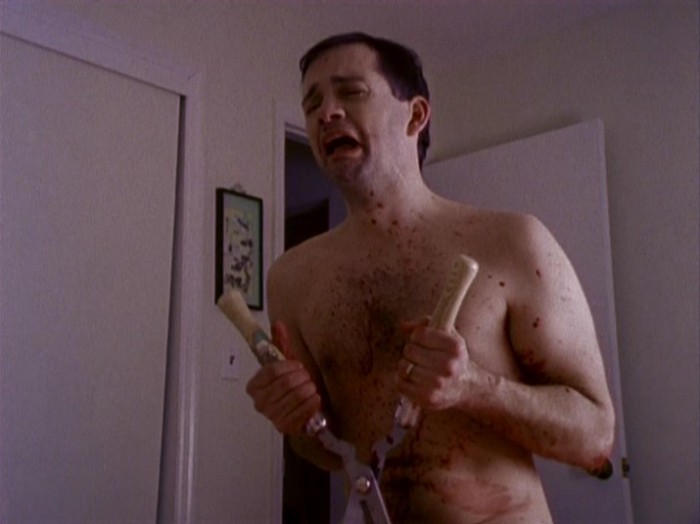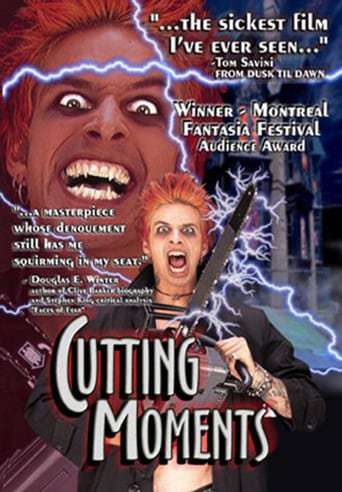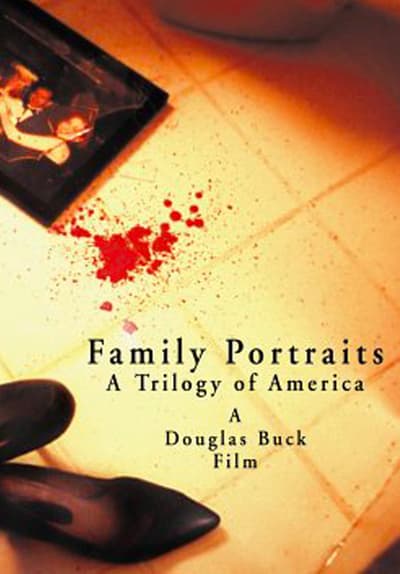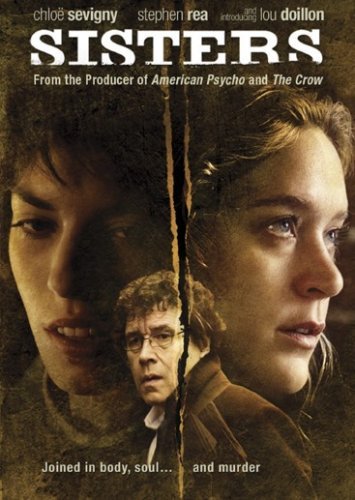1996’s “Cutting Moments” is, quite simply, one of the most powerful short films of any sort to emerge in the last 30 years.
 The film is legendary for its violent content, which is extreme even by modern horror movie standards. Yet the bloodletting of “Cutting Moments” isn’t on hand to titillate or exploit in any way (although quite a few commentators have claimed otherwise). Joe Bob Briggs once stated that “I am opposed to power drills through the ear, machetes through the stomach, decapitations with barbed wire, flamethrower attacks, and mutilation with ball peen hammer, unless it’s necessary to the plot.” While there’s little in the way of a “plot” to be found in “Cutting Moments” (nor any drills through ears or barbed wire decapitations) its extreme violence IS necessary, and even integral to its corrosive portrayal of a family in extreme crisis.
The film is legendary for its violent content, which is extreme even by modern horror movie standards. Yet the bloodletting of “Cutting Moments” isn’t on hand to titillate or exploit in any way (although quite a few commentators have claimed otherwise). Joe Bob Briggs once stated that “I am opposed to power drills through the ear, machetes through the stomach, decapitations with barbed wire, flamethrower attacks, and mutilation with ball peen hammer, unless it’s necessary to the plot.” While there’s little in the way of a “plot” to be found in “Cutting Moments” (nor any drills through ears or barbed wire decapitations) its extreme violence IS necessary, and even integral to its corrosive portrayal of a family in extreme crisis.
Listening to the DVD audio commentary I was struck by the references to Jean-Luc Godard, Andrei Tarkovsky and other cinematic luminaries by writer-director Douglas Buck, names most gorehound filmmakers probably couldn’t spell, much less identify. Obviously Buck’s sensibilities are far removed from those of most of his fellows, and indeed, Cutting Moments” is striking for its intelligence as much as its gore quotient.
Surprisingly enough for a film as overtly nasty as “Cutting Moments,” its power derives largely from subtlety. Much about the traumatized principals—a suburban father, mother and young son—is left unexplained, yet Buck still manages to convey a sense of deeply ingrained psychosis in the fraught glances the wife (Nicca Ray) gives her husband (Gary Betsworth), the disturbing sexually-tinged acts their son performs with his power ranger dolls, and the rather overly aggressive manner with which Betsworth trims a hedge in an early scene. Thus, when the nastiness starts up around the 10 minute mark it doesn’t seem terribly surprising or out of place.
Specifically, Ray tries to seduce her husband, who is too engrossed in a TV baseball game to pay her much mind. This leads to a lacerating bout of self-mutilation that concludes with Ray attempting once again to seduce her hubbie, this time covered in blood–which given the state of their relationship proves quite appropriate. What follows is a horrendously twisted coupling in which the garden shears from the opening scene are utilized in superlative gore effects by the great Tom Savini, albeit to far different, more impacting ends than Savini’s FX work on FRIDAY THE 13th and other stalk-and-slash programmers.
The cozy suburban décor that we in America have been taught to revere—incorporating the TV baseball game, Power Rangers dolls and impeccably groomed front yard—lend the proceedings a sense of familiarity that may well be the film’s most disturbing aspect. In other words, the profoundly twisted family dynamic on display here upsets precisely because it hits so close to home.
__________ __________
“Cutting Moments” was powerful enough that it achieved something very few short films ever do: it received a commercial release on  home video—twice. Its initial release occurred in 1997, on a VHS from EI Independent Cinema.
home video—twice. Its initial release occurred in 1997, on a VHS from EI Independent Cinema.
That VHS was marked by trashy cover art typical of EI’s releases, as well as four other shorts included, presumably, to pad the tape to feature length. Their inclusion is inappropriate, I’d say—as all operate on a far different, more shallow wavelength than “Cutting Moments”—not to mention unfair, as none can hope to match the power of the compilation’s titular entry.
For the record, the package commences with “Crack Dog,” directed by Casey Kehoe, a silly number about a pizza delivery man (Daniel O’Shea) with a man-eating poodle who takes on a band of homicidal crack heads. In the Tom Healy and Gino Panaro helmed “Don’t Nag Me” a man (Tom Healy) buries the corpse of his bitchy wife, who he’s just killed, in a cemetery one night, but gets caught when the body is dug up; a competently made film to be sure, but it suffers from an irritatingly drawn-out narrative. “A Bowl of Oatmeal,” credited to six directors, is a brooding effort about a schizophrenic slum dweller (Pietro Gonzales) who’s bossed around by a talking bowl of oatmeal(!); it ends with a mighty striking image, of the protagonist in bed with pieces of meat shaped like a person, but the pic overall is annoyingly cryptic. Next up is “The Principles of Karma,” written and directed by future TODD AND THE BOOK OF PURE EVIL creator Craig David Wallace, about a suicidal punk (Mike Richen) abducted by a flamboyant cable TV repairman (Adam Harrington) who’s dedicated to reprogramming complacent teens; an oft-amateurish effort to be sure, but it’s also quite witty and energetic, and boasts a lively heavy metal soundtrack. But the best, of course, is saved for last—yes, “Cutting Moments” rounds the tape out, and all-but wipes the preceding shorts off the screen.
__________ __________
 In 2004 “Cutting Moments” had its second home video release, this time on DVD as part of a three-part anthology project called FAMILY PORTRAITS: A TRILOGY OF AMERICA, which featured two subsequent Douglas Buck helmed shorts. The DVD wisely gives viewers the choice of viewing the three shorts by themselves, which I feel is the ideal way to experience them.
In 2004 “Cutting Moments” had its second home video release, this time on DVD as part of a three-part anthology project called FAMILY PORTRAITS: A TRILOGY OF AMERICA, which featured two subsequent Douglas Buck helmed shorts. The DVD wisely gives viewers the choice of viewing the three shorts by themselves, which I feel is the ideal way to experience them.
“Cutting Moments” begins FAMILY PORTRAITS, leaving the following shorts with a lot to live up to. Luckily “Home,” shot in 1998, nearly equals the brilliance of its predecessor. It once again stars Gary Betsworth, playing another disturbed suburbanite. “Home” has been dubbed a sequel of sorts to the earlier film, showing what might have happened to the kid in “Cutting Moments” as an adult. We see the very grown-up Betsworth struggling with a fraught relationship with his wife and daughter; the tension, as flashbacks reveal, is bequeathed by his father, in whose footsteps Betsworth is determined to follow. The problem is the old man was a misogynistic scumbag who inculcated a legacy of hate and bloodlust that finds its outlet in an act of apocalyptic violence.
As with “Cutting Moments,” “Home’s” primary power is in its refinement, with Buck dissecting his protagonist’s disturbed psyche with a great deal of savvy and intelligence. There are some admittedly distracting flaws, including overly expository narration and some irritatingly stilted staging, reflecting what is said to have been an extremely difficult shoot. But Buck’s filmmaking talent is undeniable, and makes for a strong and powerful body-slam of a film.
“Prologue” turned up in 2002. At 52 minutes it’s the lengthiest of FAMILY PORTRAITS’ segments, and also the most mature. There’s no gore whatsoever to be found in this film, which intercuts the activities of a retired postal worker (William Mahoney) and his wife, who are coming to terms with a horrific past, with the travails of a wheelchair bound young woman (Sally Conway) recovering from a recent attack. The connections between the two strands gradually become apparent as we learn that the ex-postal worker was in fact the young woman’s attacker. Buck provides no easy answers or pat solutions to these characters’ respective dilemmas, although the final scenes are quite conclusive. Not to give anything away, but the young woman finds absolution of a sort, while the elderly couple have no such luck.
As we’ve come to expect from Buck, the film boasts uniformly strong performances and superlative visuals that belie the low budget. The unrelievedly dour tone, however, is more annoying than it was in the previous segments given “Prologue’s” inflated running time. Another problem is with the final shot, which is a bit too wide, making it difficult to tell what is happening (I had to listen to Buck’s DVD commentary to find out precisely what occurs).
__________ __________
In the years since “Cutting Moments” and its follow-ups Douglas Buck has remained active. He made his feature debut, unfortunately  enough, with 2006’s straight-to-DVD remake of Brian De Palma’s SISTERS. To be fair, Buck clearly made a concerted effort to create something resonant, with classy photography, measured pacing and a brooding atmosphere that will be familiar to viewers of his shorts. There’s also a great deal of sex and gore, but it hasn’t a fraction of the impact of “Cutting Moments,” with SISTERS registering as a pointless and misguided effort that adds nothing to an otherwise distinguished filmography.
enough, with 2006’s straight-to-DVD remake of Brian De Palma’s SISTERS. To be fair, Buck clearly made a concerted effort to create something resonant, with classy photography, measured pacing and a brooding atmosphere that will be familiar to viewers of his shorts. There’s also a great deal of sex and gore, but it hasn’t a fraction of the impact of “Cutting Moments,” with SISTERS registering as a pointless and misguided effort that adds nothing to an otherwise distinguished filmography.
In 2008 a second Buck directed feature was announced, an eco-themed splatter fest entitled THE BROKEN IMAGO, which came complete with a teaser trailer that was widely circulated online—and which, sadly, is the extent of the film to date. Following that was a segment of the 2011 anthology film THE THEATRE BIZARRE entitled “The Accident,” an unexpectedly powerful examination of death, as seen through the eyes of a little girl who witnesses a bloody motorcycle accident. It’s THE THEATRE BIZARRE’S most memorable segment, and proves that despite the crumminess of SISTERS Douglas Buck remains a force to be reckoned with. I can’t help but feel, however, that he’ll never recapture the fearsome brilliance of “Cutting Moments.”
Let’s hope I’m wrong.
